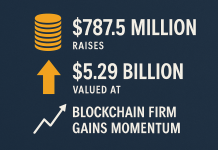[ad_1]
The derivatives market in the Blockchain ecosystem has been quietly growing in the past year. The two largest derivatives exchange, BitMEX and OKEx are seeing over $700 million in trading volume daily, with OKEx reaching over $2 billion at its peak. The primary driver of revenue growth at the respective exchange is a perpetual swap, which is an innovative product that resembles futures contract, except that it does not have an expiry date and no exchange of underlying asset of contracts will take place. Collectively, the popular cryptocurrency trading product has recorded “an estimated $100 billion in total trading volume” since its launch.
What are derivatives?
Derivatives are financial instruments in the form of contracts, the value of which is derived from the value of an underlying asset. Though the earliest recorded derivatives trading occurred in the 1500s, derivatives have only grown to the massive scale that we are currently witnessing in the last 50 years.
The recent history of derivatives is characterized by its broad integration into commerce and finance. Modern financial architecture has contributed to the remarkable rate of globalization of the capital market, and derivative instruments function as an adapter for the integration of the markets. In the greater scheme of things, derivatives allow the flow of funds and risk sharing among national systems with different institutional shapes and sizes. As such, the growth of the derivatives market is usually an indication of expanding market opportunities and demand.
Derivatives in conventional economies
Since the 1970s, the growth of derivatives had been driven by rising volatility in stocks, interest rates, and exchange rates, along with globalization of capital markets on the demand side, while advancing technology and financial engineering played important roles on the supply side.
From a report about Global Derivatives Market by De Gruyter, the global derivatives market is valued at $1.2 quadrillion, while some analysts predict that the derivatives market is more than 10x the size of total world gross domestic output. This enormous value is largely a result of the inclusion of numerous derivatives: equities, commodities, bonds, and foreign currency exchange. And beyond that, derivatives allows for additional leverage to be created, thereby magnifying the size of the market.
As to why the significant growth and impact of the financial product in the last 50 years, derivatives have been commonly utilized by entities for risk management and risk control functions. More than just risk aspects, the ability to provide mechanisms for pooling and trading allows for financial institutions to benefit from derivatives through lower funding costs and more diversified funding sources.
These propositions by derivatives, in turn, encourage reallocation of investment towards higher return activities with positive implication on economic growth, which resulted in further creation of derivative instruments for an even greater range of risk profiles.
Cryptocurrency derivatives
Observations from history tell us that derivatives follow the growth of financials market, and will be inevitable as the sector matures. This would likely hold true in the case of cryptocurrency, where derivatives are already sprouting.
Today, the cryptocurrency ecosystem is very diverse, with over 2,000 unique coins and tokens spreading over 16,000 markets, and the level of financial activities in the cryptocurrency sector is consistently growing. Like the conventional financial market, the greater participation in the cryptocurrency ecosystem from consumers and businesses will encourage market participants to consider derivatives for risk management and a means for revenue generation. With time, the growth of derivatives will result in deeper penetration into existing markets and commerce activities, making these instruments unavoidable.
Incumbents will soon to be joined by upcoming new exchanges, as they offer innovative solutions to traders in order to establish themselves in the market. One of the exciting upcoming exchanges is ArcaFX, which offers derivatives trading and will be issuing its own token, ARCA, that subjects token holders the right to participate in its buyback program.
Unlike other incumbent derivatives exchanges, ARCA token is in place to provide incentives for traders to stay committed to the platform. To properly motivate ArcaFX traders, ArcaFX will be conducting regular token buybacks using the platform revenue, thereby creating a positive loop that encourages trading activities on ArcaFX. With this implementation, money can be returned to token holders which can be redeployed in innovative enterprises in the sector with promising growth.
What’s next
Derivatives have been a good predictor of the long run growth of a sector, and a good indicator of the rate of improvement in the efficiency with which economies allocate capital resources. The robustness of the cryptocurrency sector today will call for a greater demand for derivatives to cater to the different needs that entities would encounter.
Given the current growth that the sector is experiencing, it is reasonable to deduce that more types of contracts will be launched by different exchanges to cater to everyone. Not only that, but we can also expect more sophisticated products such as sector-specific swaps to be introduced. As more derivatives are introduced, the ecosystem will continue to see improvement in liquidity and vibrancy in the products involved.
[ad_2]
Source link





